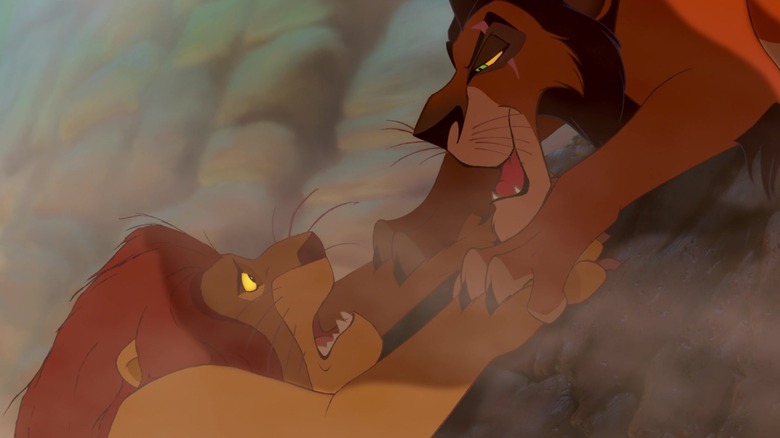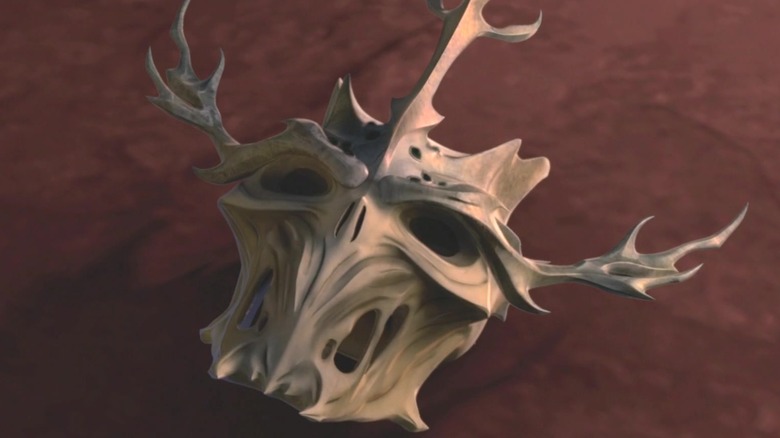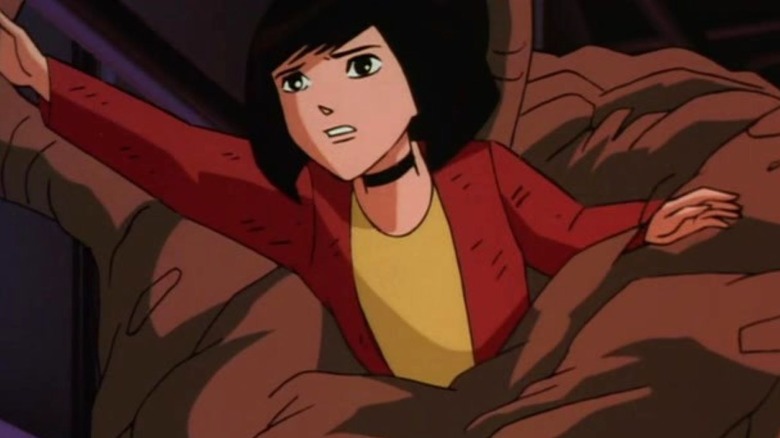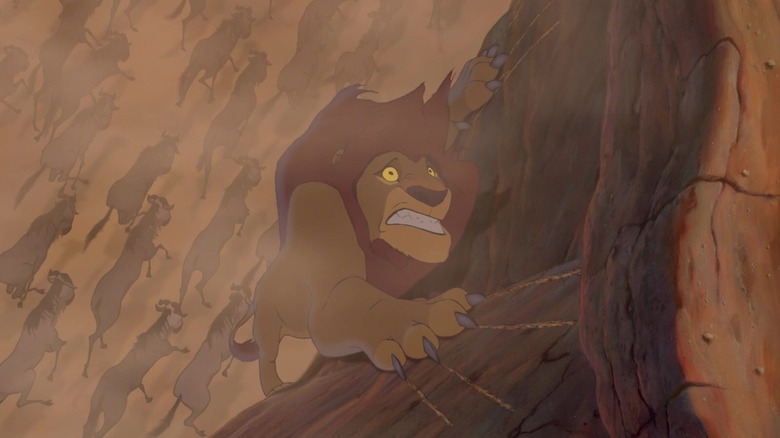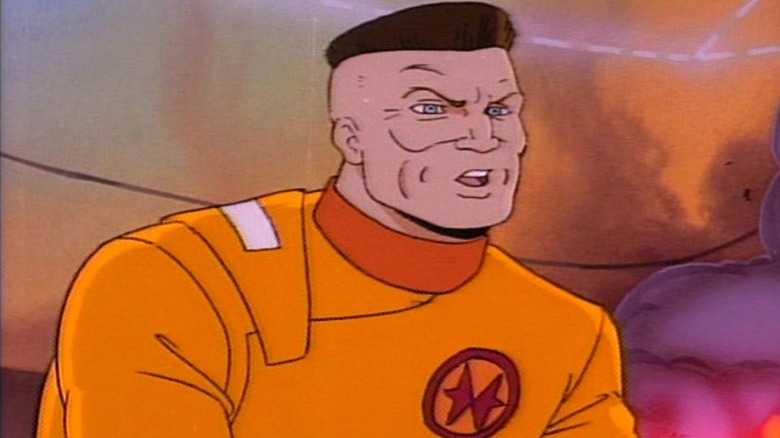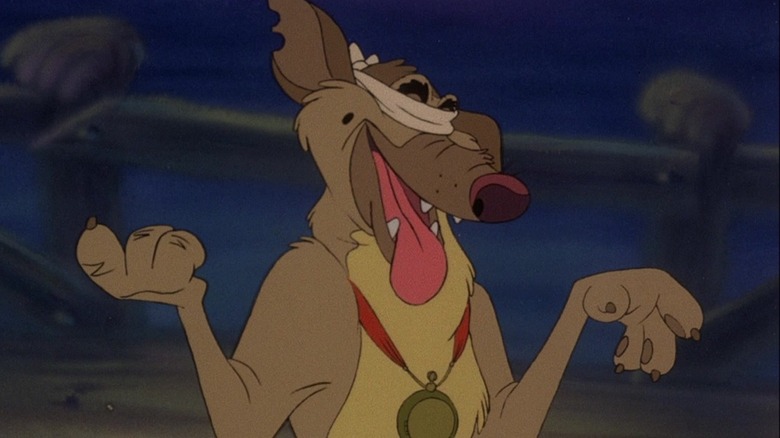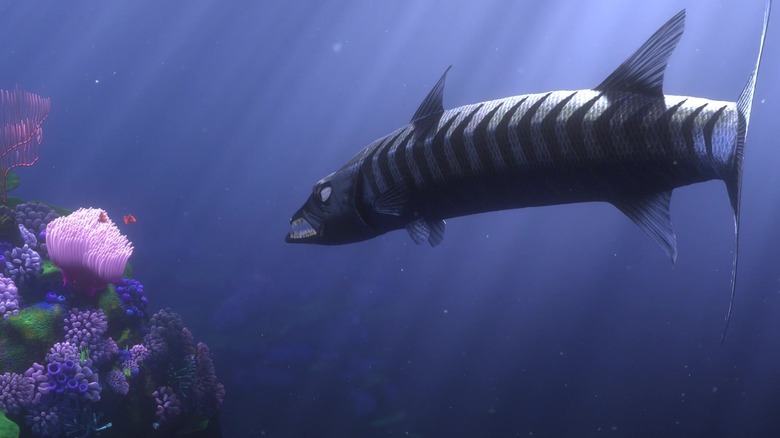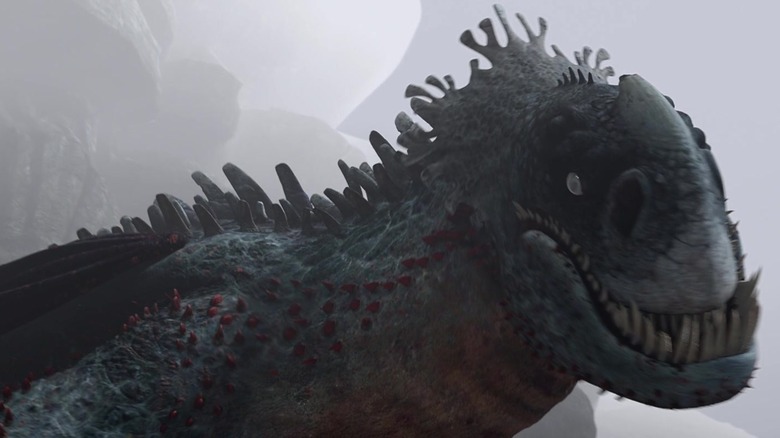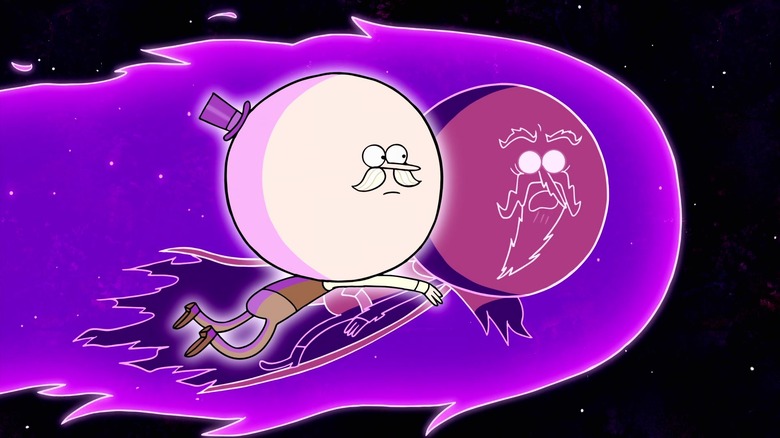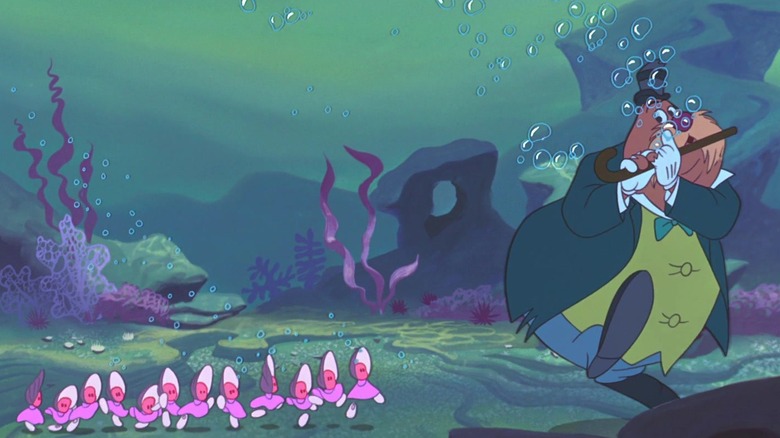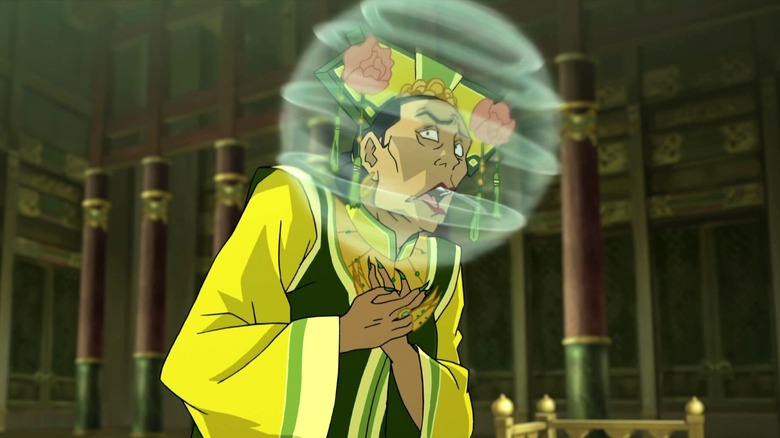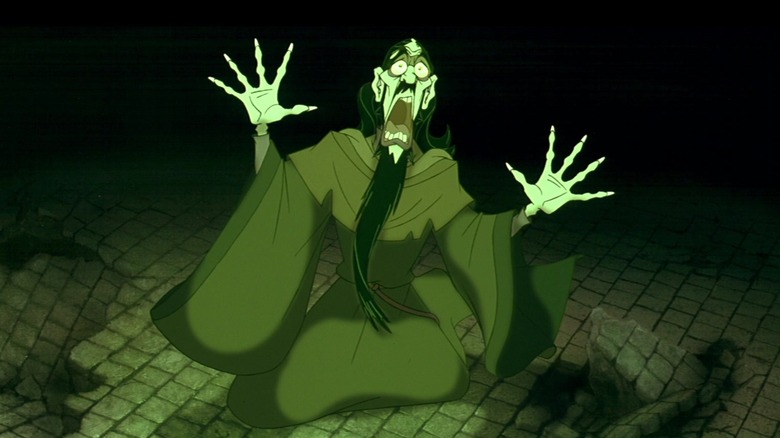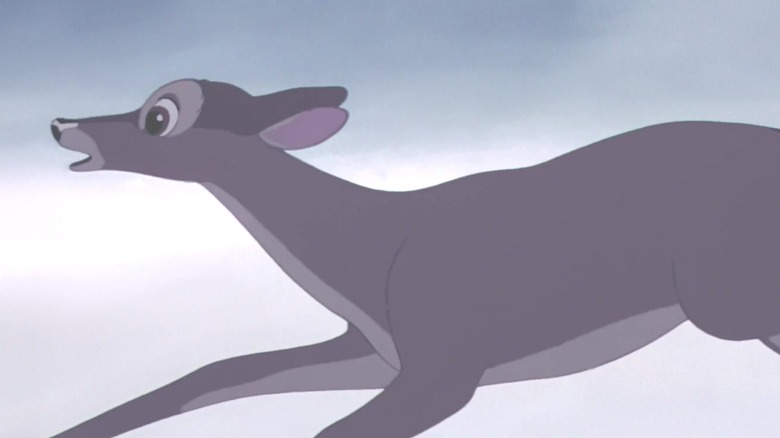The 12 Worst Deaths In Kids' Shows & Cartoons That Were Genuinely Disturbing
Positive messages, bright colors, adorable musical numbers, and funny one-liners. They're the essential ingredients used in many animated TV shows and films made for kids. And they can also be the ingredients that lull audiences into a false sense of security that is only disrupted by the sudden, disturbing death of a character. Big laughs turn into uncontrollable tears as viewers helplessly watch on the sidelines.
Of course, death is never an easy subject to include in children's entertainment, but some of these demises are genuinely disturbing — from the sudden loss of the king of Pride Rock to a dog being run over by his arch-nemesis. These are just some of the shocking moments that live rent-free in the minds of children who become grown adults who recall — and sometimes rewatch -– these traumatic scenes with future generations. Some of these moments are even included in films that make up Looper's list of best family movies of all time, but that still doesn't change the fact that many of these grisly scenes are best watched through fingers or with a trusted friend. Here are 12 deaths in kids' shows and cartoons that are genuinely disturbing.
Super Shredder's decapitation on Teenage Mutant Ninja Turtles
The Teenage Mutant Ninja Turtles are on the hunt for Super Shredder (Kevin Michael Richardson) in "Teenage Mutant Ninja Turtles," Season 4, Episode 26, "Owari." This episode in the 2012 series begins shortly after Super Shredder kills their sensei Splinter (Hoon Lee), and now they're on a mission to avenge his death. Donatello (Rob Paulsen) hits him with a retro-mutagen, but it's not enough to take him down. Leonardo (Seth Green) becomes the turtles' only hope, and he finds a way to pin Super Shredder down before decapitating him. While the actual beheading is not shown on camera, Leonardo tosses Super Shredder's helmet down to his teammates, implying the cause of death.
This episode of "Teenage Mutant Ninja Turtles" plays out more like a dramatic action tale instead of a fun, adventurous kids' show, and the disturbing death of Super Shredder sends that dramatic vibe home. The big moment is also a signal that this big adversary is gone for good and that a new chapter is on the horizon for the Turtles, who will clearly do anything they can to defeat evil, even if that includes shocking young viewers who will probably never forget this gruesome moment in "TMNT" history.
Clayface absorbs Annie in The New Batman Adventures
There is no shortage of animated adventures for Batman and Robin, but one moment on "The New Batman Adventures" will have viewers watching the screen through their fingers. Season 1, Episode 8, "Growing Pains," follows Robin (Matthew Valencia) as he tries to help Annie (Francesca Marie Smith) regain her memory. They eventually make their way to pipes near a lighthouse, and Annie remembers that she is the daughter of Clayface (Ron Perlman), who created her after he plummeted into the water on "Batman: The Animated Series," Season 2, Episode 3, "Mudslide." Clayface wants her back, and she surrenders herself to save Robin. The young hero watches helplessly as Annie spends the next several seconds in visible pain as she is absorbed into her father. She then begs Robin to flee before disappearing into the villain's body.
The painful absorption is extremely cringe-worthy, easily making it one of the moments from the DC Animated Universe that went too far. However, it's not just the visuals that make this moment heart-wrenching. Earlier in the episode, Robin and Annie both realize that their fathers are not in the picture, and this creates an emotional bond between the two. That connection drives Annie's choice to save Robin as Clayface holds him over water. Her sacrifice shows the strength of her relationship and just how much she truly cares for Robin.
Mufasa's murder in The Lion King
In this cinematic moment that has haunted kids since 1994, "The Lion King" villain Scar (Jeremy Irons) creates a murder plot where Simba (Jonathan Taylor Thomas) is told to wait in a gorge before Scar's hyenas startle a herd of wildebeest. Simba is on a run for his life, and his father, Mufasa (James Earl Jones), gets him to safety before climbing his way up a cliff. He is almost to the top where Scar is waiting, but he's not there to lend a helping paw. Scar digs his claws into his brother and violently tosses him toward the ground below, leaving viewers on the edge of their seats. Once the dust from the stampede settles, Simba finds Mufasa dead.
Of course, this is just one of the many Disney deaths that traumatized us as children. While there are no direct depictions of Mufasa being trampled, much of his death is captured on camera. It's a jaw-dropping moment that leaves viewers processing emotions of shock and grief. This after enjoying toe-tapping numbers like "I Just Can't Wait to be King" and laughing at one-liners from Zazu (Rowan Atkinson). Even Matthew Broderick, who voiced the older version of Simba, told Yahoo! Entertainment that this moment made the movie a tough watch for his family. "We've learned it's not as fun to watch with kids as you might think," he said.
Matthew Marcus' death on Exosquad
"Exosquad," Season 1, Episode 11, "The Brood," is an action-filled 22 minutes that tragically ends with the death of Captain Matthew Marcus (Richard Newman). The episode begins in the midst of Captain Marcus' mutiny against Admiral Winfield (Walter Marsh). The captain is on a mission to liberate Earth, but his plans face grave uncertainty when two fleets of Neosapiens attack the Resolute. Following severe damage, Captain Marcus tries to protect the ship with a different maneuver strategy, but it's too late. Another round of attacks causes the ship to start falling apart. He commands the crew members to evacuate before he causes the ship to implode while he is still on board.
Captain Marcus makes his intentions known when he tells Kaz Takagi (Michael Benyaer) to give Admiral Winfield a message about his death. This is after Takagi attempts to rescue him. Following a brief close-up of Captain Marcus' face, the scene cuts to a wide shot of the ship, showing the implosion from the bird's eye view. Admiral Winfield's emotional reaction adds more gravity to this somber scene, showing how deeply he cares for his crew member, even though they don't always see eye to eye.
Charlie's murder in All Dogs Go to Heaven
A movie with the title of "All Dogs Go to Heaven" is bound to have some dark moments, but Charlie's (Burt Reynolds) death will leave viewers in disbelief. Carface (Vic Tayback) is upset that Charlie has left Death Row, telling his sidekick, Killer (Charles Nelson Reilly), that he no longer wants to share his gambling business with Charlie. Charlie does agree to go into business for himself, but Carface uses this as an excuse to have a party where his former partner becomes intoxicated. His henchmen then lead Charlie to a pier where he is blindfolded before Carface runs him over with a car. The scene comes short of showing the car making an impact, but the vehicle is shown flying off the pier shortly before Charlie flies to Heaven.
It's one of the many adult scenes that make up this G-rated film, which begins with Itchy (Dom DeLuise) and Charlie being shot at after they cause a water main to blow. Before Charlie's gruesome end, Killer suggests that Carface should harm him with pliers instead, proving that this movie could have been even more traumatizing than it is. Many kids of the late '80s will recall the laughs and bright colors that this film brought to the big screen, but a rewatch will make many realize that the joyous parts of this film are catapulted by plenty of dark humor and references to gruesome violence, including Charlie's untimely end.
The barracuda attack in Finding Nemo
"Finding Nemo" is a fish-out-of-water tale that starts with plenty of jokes, colorful scenery, and adorable animal stars, sending the audience into a Disney trance. Marlin (Albert Brooks) and his partner Coral (Elizabeth Perkins) are celebrating their new home as they await the hatching of their clownfish eggs, but the arrival of a barracuda changes the mood so suddenly that audiences are sitting on pins and needles. Coral races to protect the eggs as Marlin tries to fight off the carnivore. He is knocked unconscious and awakes to find that the only survivor is Nemo, later voiced by Alexander Gould.
Pixar and Disney are a dynamic duo when it comes to delivering stories that tug at the heartstrings, and "Finding Nemo" is no different. However, this installment in the Pixar universe puts grief and sudden loss right at the movie's forefront, directly connecting with audience members. Marlin's goal is to do everything he can to protect Nemo, who feels like his dad has taken things a little too far. However, Marlin's constant worry could also be a way that he is processing his grief over the loss of Coral and Nemo's siblings, thinking that maybe he could have done more to protect them.
Red Death's defeat in How to Train Your Dragon
"How to Train Your Dragon" is meant to turn the rough and tough world of Vikings into an adorable family adventure that is complete with an underdog protagonist named Hiccup (Jay Baruchel) and a lovable dragon named Toothless. While there are several things that only adults notice in "How to Train Your Dragon," the gruesome nature of the villain's death scene will not go unnoticed by children. The film does delight kids and adults alike, but the battle between Toothless and Red Death could rival that of action scenes from "Game of Thrones" and "House of the Dragon." Following several attempts to fend off this villain, Toothless shoots a plasma blast into the dragon's throat, causing Red Death to crash to the ground with his wings tearing apart from the force of gravity.
It's a dramatic end to a film that's filled with many intense moments, including depictions of Red Death eating dragons out of thin air. This shows how tough and gruesome Red Death is, meaning that the creature's defeat will be no easy task. This could be the reason why this villain's demise is so detailed. The takedown happens after several minutes of battle which helps to create a lot of build-up that can only be rightfully resolved with a big finish, hence the tearing of the dragon's wings. However, showing Toothless shooting plasma straight into the dragon's mouth also shows just how powerful this Night Fury can be.
Pops sacrifices himself on Regular Show
This epic two-part ending to "Regular Show" begins with Pops (Sam Marin) and the rest of the crew heading to his home planet, Lolliland. It's here that Pops and his evil brother Anti-Pops (Robert Englund) begin their epic face-off, fighting for the fate of the universe during Season 8, Episode 27, "A Regular Epic Final Battle." The fight concludes as Pops hugs Anti-Pops and sends them both into a star, killing the brothers.
Pops' death is a moment that is only made bigger due to the fact that the "Regular Show" finale is as big as it is. Pops spends much of the finale trying every physical attack that could defeat Anti-Pops, but nothing works. He realizes that love is the answer, inspiring him to hug Anti-Pops, effectively shrinking him as they head toward the star. Defeating evil with love is the perfect choice for a character who is known as the embodiment of pure good. This makes the finale even more heart-wrenching for viewers, but it also makes the closing seconds even sweeter because it features Pops enjoying the lives of his friends while in Heaven, adding extra emotion to an already tear-jerking sendoff.
Curious oysters eaten in Alice in Wonderland
It's the cinematic moment that could make anyone cry upon being served a plate of oysters. Disney's 1951 animated adaptation of Lewis Carroll's "Alice in Wonderland" features the story of the walrus and the carpenter, who devise a plan to turn a group of curious oysters into their next meal. All of the characters in this side-adventure are voiced by J. Pat O'Malley, who seamlessly changes his voice between the tricksters and the curious oysters who happily parade behind the walrus — the same creature who lied to them to lure them to the dining table. As the carpenter prepares the rest of the meal, the oysters notice a menu stating that they're the special of the day. The walrus gathers the oysters in an embrace before eating them, with the actual devouring happening off-camera. However, there is no denying what has happened when the carpenter returns to the table and sees the pile of empty shells.
Tweedledee and Tweedledum (both voiced by O'Malley) share the story with Alice (Kathryn Beaumont) as a warning to not let her curiosity get the best of her. However, this tale and its imagery are so dark that parents and kids will spend more time processing what they just saw instead of processing the lesson at hand. Disney's hand-drawn animation style mixed with bright pastels and other rich colors make this moment even more unsettling since such colors induce more happy vibes rather than the despair that is at the center of this tale.
The Earth Queen is suffocated on The Legend of Korra
Zaheer (Henry Rollins) is on a mission to build a new world, and Season 3, Episode 10, "Long Live the Queen," shows that he won't let anyone get in his way, leading to one of the most gruesome death scenes on "The Legend of Korra." As the Earth Queen, Hou-Ting (Jayne Taini), waits for the Earth Kingdom forces to bring Korra (Janet Varney) to her throne, Zaheer tries to bargain for information regarding Korra's whereabouts. The Earth Queen refuses to share any details with him, causing him to retaliate by using airbending to pull the air out of her lungs.
It's a horrifying moment that gains extra visual emphasis due to the detailed animation that makes this scene so graphic. The Earth Queen's breath is visible due to a color choice that is similar to fog. The air from her lungs then wraps around her head, spinning faster and increasing the speed of her suffocation. The continuous movement of the air creates a translucent orb that almost makes it look like she's suffocating in a glass bowl. Ranked by Looper as one of the best episodes of "The Legend of Korra," "Long Live the Queen" is a spine-chilling episode that uses this jaw-dropping moment to show just how destructive Zaheer can be.
Rasputin is destroyed by Anastasia
Amid the fun dance numbers, jokes, and adorable dog sidekick, "Anastasia" is filled with dark undertones, and Rasputin's (Christopher Lloyd) death is no exception. The 1997 film ends with an adult version of Anastasia (Meg Ryan) crushing his life force, causing winged, demon-like creatures to rain down upon him before his flesh is liquified and his bones are turned to dust. It's a sinister ending for an evil character who spends much of the film devising attacks on Anastasia, the young woman who evaded his attack on her family so many years ago.
Since the demise of the Romanov family, Rasputin has taken residence in the underworld, which seems to add to his powerful nature, allowing him to find ways to attack Anastasia in the world of the living. His dastardly deeds paired with the animation and Lloyd's menacing voiceover send the message home that this is one bad wizard. Rasputin's larger-than-life personality and villainous ways could be why the writers gave him such a big, terrible ending as they tried to match the intensity of his death to that of his actions. Nonetheless, it's a moment that will make viewers put down the popcorn and momentarily turn away from the screen until they hear the wind take away the dust that was once Rasputin's bones.
The death of Bambi's mom
The mere mention of this Disney moment could make anyone automatically cry. The 1942 classic begins with a young Bambi (Donnie Dunagan) and his mother (Paula Winslowe) being chased by a hunter's gunshots. They are almost to safety when one gunshot sounds and Bambi's mother is no longer behind him. He continues to run for cover, thinking that she is still following. It's not until he reaches a cave that he realizes he is alone and begins to desperately cry out her name.
It's probably one of the most devastating off-camera deaths in cinematic history, and it has since become a part of the fabric of pop culture. In a Yahoo! Entertainment Facebook Live interview, "The Lion King" director Rob Minkoff said the disappearance of Bambi's mom influenced the death of Mufasa. "Then his dad shows up and says, 'Your mother can't be with you anymore.' It's really sad, and then they go to this new song, it's like a spring song. The birds are singing happily in the trees, and it's really disturbing," he said, adding that this is why they decided to show Simba coming to terms with his father's death on-screen.
While there are many moments that add to the reason why "Bambi" is actually terrifying, the sudden on-screen absence of Bambi's mom makes his cries more agonizing for the viewer. This quickly brings about a deep sense of loss, despair, and desperation for a young deer whose main protector is now gone.
